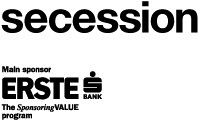Alexandra Bircken: Unruhe
Korakrit Arunanondchai
September 13–November 10, 2019
Friedrichstraße 12
1010 Vienna
Austria
Hours: Tuesday–Sunday 10am–6pm
T +43 1 587530710
F +43 1 587530734
presse@secession.at
The Vienna Secession is pleased to announce the exhibitions by Tillman Kaiser, Alexandra Bircken and Korakrit Arunanondchai.
Tillman Kaiser
Im Dom
In his exhibition Im Dom in the Secession’s main gallery, Tillman Kaiser presents a new cycle of large-format pictures and sculptures created especially for the occasion.
A church or cathedral is not a functional structure; synthesizing diverse arts—architecture, sculpture, and painting—it possesses a beauty that is an end in itself. With a nod to the Kantian idea of disinterested pleasure, Kaiser argues that all art—his, certainly—aspires to beauty in this sense. Made in the studio, his work does not depend on the interaction with a specific exhibition site. And yet the half-laconic, half-ironic title he has chosen for his show, which translates as In the Cathedral, transplants us into an ecclesiastical space and hints at the possibility of a spiritual experience. It is a deft stratagem, drawing a connection between the Secession—conceived at the dawn of modernism as a total work of art and “temple” of beauty—and his own oeuvre while questioning the institution’s status and signaling critical distance.
Kaiser’s pictures combine photography with painting and graphic art. Photographs recorded with a homemade camera obscura as well as cyanotypes made without the use of a camera are the material he subsequently reworks in a painterly process. Each photo from the pinhole camera consists of several pieces of photographic paper, and his pictures, usually in large formats, are in turn composed of multiple photographs pasted onto the canvas. The basis of his works, then, is always already a collage, synthesizing different motifs as well as the iteration and variation of a single motif on one surface and lending the pictures a distinctive rhythm and complexity.
Eyes, ritual masks, a model of a church, and other references from the artist’s studio are central motifs in his work, making frequent appearances in both pictures and sculptures. Most recently, the two genres seem to be coalescing: elements from the sculptures, cobbled together out of a variety of materials, figure in the pictures as photographic images; the sculptures conversely quote structures and motifs from the pictures.
Tillman Kaiser was born in Graz in 1972 and lives and works in Vienna.
Alexandra Bircken
Unruhe
The human body and the various shells that, as skin and attire, define its relation to the world are key motifs in Alexandra Bircken’s work. Many of her sculptural investigations probe the question of the boundary between inside and outside and how it can be imagined as a permeable membrane, interface, and suture.
For her exhibition at the Secession, Bircken has developed a number of new works. Deflated latex figures in the stereotyped colours pink and baby blue scrutinize entrenched and simplistic understandings of gender. They are set in relation to various body fragments and prints on highly polished stainless steel showing anthropomorphic knitted objects, a series that operates with the viewer’s self-reflection. Such encounters between disparate objects in a shared space are often also characteristic of individual sculptures by Bircken. For Motorradschaukel, for example, she has mounted a Yamaha R6 racing bike on curved wooden rockers instead of wheels. The powerful machine seesaws back and forth like a rocking horse but goes nowhere, despite its fully functional engine. Bircken harnesses the physical and sensual qualities of her material assemblages as well as their symbolic dimensions to elicit sometimes contrasting chains of associations: the motif of the machine as an instrument of power and vehicle of an ecstatic sense of freedom is interlinked with connotations of childhood, craftsmanship and the organic.
Alexandra Bircken was born in Cologne and lives and works in Berlin and Munich.
Korakrit Arunanondchai
The artist and filmmaker Korakrit Arunanondchai works on one large body of work that focuses on the idea of a “living archive.” His on-going video series with history in a room filled with people with funny names (2012—) features a fictional denim painter as its recurring central character alongside the artist’s long-time collaborators and family members—most notably his grandparents. The protagonists perform in a variety of surroundings and situations that reflect upon the natural environment in the Anthropocene, technological evolution, politics, traditional beliefs and culture in transition. His multidisciplinary practice encompasses film, performance, painting, and sculpture, which he frequently combines to form lush, immersive installations. He is interested in relationships that pass through time and mutate with bodies of people, something that parallels the development of recorded history but sidesteps its linearity and single point of perspective in storytelling. Recently, he has used the method of overlaying the structural relationships that form animistic beliefs with those of the global information network. The story of the near future becomes a version of a narrative from a far imagined past, and the dichotomy between spirituality and technology increasingly seems to fall apart into a spectrum of greyness that produces a multiple “shared present.”
While Korakrit Arunanondchai turns Secession’s Grafisches Kabinett into a black box to present the three videos 2556 (2013), Painting with history in a room filled with people with funny names 3 (2015), and with history in a room filled with people with funny names 4 (2017), he uses the staircase leading up to the screening room for a floral wallpaper, using wild flowers and weeds collected in Vienna as an ode to the golden dome on the top of the Secession building. Hung above the floral wallpaper is a series of new paintings, each referencing a still from one of Arunanondchai’s videos.
Korakrit Arunanondchai was born in Bangkok in 1986 and lives and works in New York and Bangkok.
Tillman Kaiser’s exhibition will be accompanied by an artist’s edition. Alexandra Bircken and Korakrit Arunanondchai will release artist’s books created in conjunction with their exhibitions.
The exhibition program is conceived by the board of the Secession.



